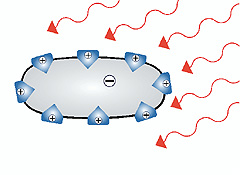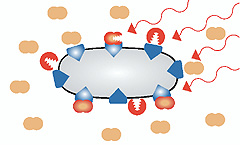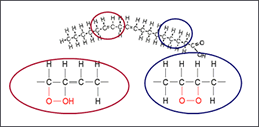Antimicrobial Photodynamic Therapy (aPDT)
Chemical / physical background
The chemical/physical process is carried out in 3 steps:
Step 1: Staining of the microorganisms
- This is a diffusion-determining step,
- with migration and attachment of the dye molecules,
- on the wall of the microorganisms. (charge attraction)

Step 2: Exposure and activation of the photosensitiser
- This is an energy-controlled step,
- determined by physical-optical properties,
- with excitation of the sensitizer molecules,
- from singlet state to triplet state.

Step 3: Oxygen radical formation and destruction of the microorganisms
- Exposure and activation of the photosensitiser leads to the build-up of singlet-oxygen and
- An oxidative destruction of membrane lipids and enzymes.

The decisive factor is a question of which biological target molecules are reached by the radical reactions:
- In principle, all molecules are affected by singlet-oxygen.
However:
- Unsaturated fatty acids in the bacterial membranes are particularly susceptible to damage.

The body's own healthy cells have cellular defences against the attack of radicals - so-called catalase or superoxide dismutase.
It is thus specifically the pathogenic bacteria that are destroyed by antimicrobial photodynamic therapy. Healthy cells are at no risk!
Further information about "Photodynamic Therapy"?
Read more on the following pages:
